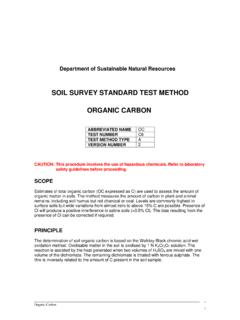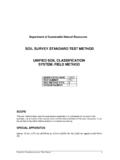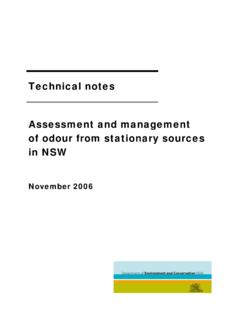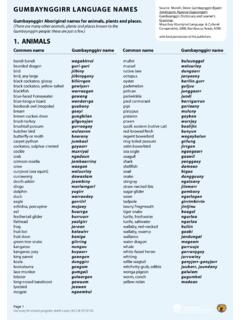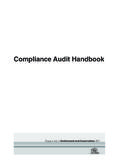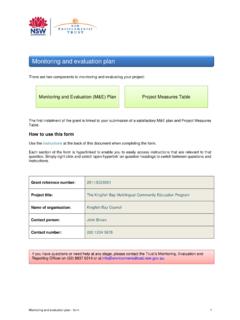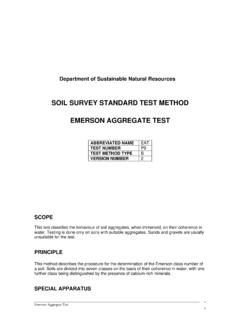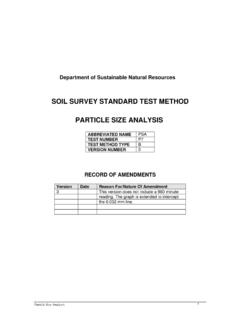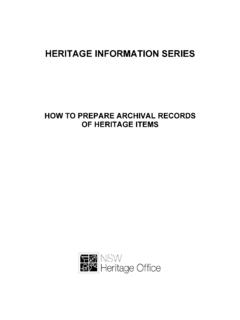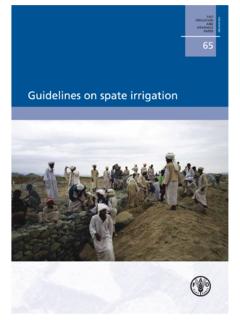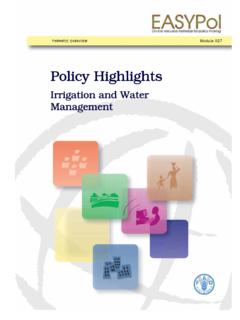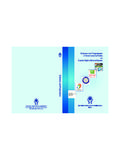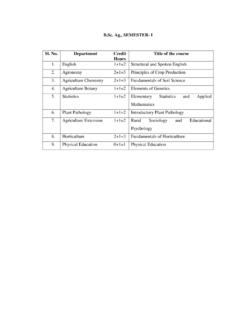Transcription of Use of effluent by irrigation - NSW Environment & …
1 ENVIRONMENTAL GUIDELINESUSE OF effluent BY irrigation ENVIRONMENTAL GUIDELINES USE OF effluent BY irrigation From 24 September 2003 the Department of Environment and Conservation (DEC) incorporates the Environment Protection Authority (EPA), which is established in the Protection of the Environment Administration Act 1991 as the Authority responsible for administering the Protection of the Environment Operations Act 1997 (POEO Act). Statutory functions and powers in the POEO Act continue to be exercised in the name of the EPA. Published by: Department of Environment and Conservation (NSW) 59 61 Goulburn Street Sydney PO Box A290 Sydney South 1232 Phone: (02) 9995 5000 (switchboard) Phone: 131 555 (information & publications requests) TTY: (02) 9211 4723 Fax: (02) 9995 5999 Email: Website: The Department of Environment and Conservation (NSW) is pleased to allow this material to be reproduced in whole or in part, provided the meaning is unchanged and its source, publisher and authorship are acknowledged.
2 ISBN 1 74137 076 0 October 2004 DEC 2004/87 Printed on recycled paper Foreword Water recycling is becoming a critical element for managing our water resources. By safely irrigating recycled water, sustainable development can be achieved while conserving our high quality water supplies. Being able to access alternative safe water sources is particularly critical in times of drought. By providing an additional source of water, recycling can help to decrease the diversion of water from sensitive river and wetland ecosystems. Another major benefit of effluent reuse by irrigation is the decrease in wastewater discharges to natural waterways.
3 When pollutant discharges to waterways are removed or reduced, the pollutant loadings to these waters are decreased. Substances that can be pollutants when discharged to waterways can be beneficially reused for irrigation . For example, plant nutrients such as nitrogen and phosphorus can stimulate harmful algal blooms in waterways but are a valuable fertiliser for crops. In some cases, returning well treated water to rivers might provide a better outcome than reuse by irrigation , for example, to supplement river flows. This Guideline will however help increase the options available for water management, particularly those sources of wastewater that are not suitable or adequately treated for safe discharge to our rivers, estuaries and oceans.
4 Many water needs can be satisfied with recycled water as long as it is adequately treated to ensure water quality is appropriate for the proposed use. Greater treatment and management is required for uses where there is a greater chance of human exposure to the recycled water. effluent can pose environmental, public health or agricultural resource risks if not managed appropriately and the information in this Guideline will support the establishment of safe effluent irrigation reuse schemes. Water recycling has proven to be effective and successful in creating a new and reliable water supply, while not compromising public health.
5 effluent reuse by irrigation is now an accepted practice that will play a greater role in our overall water supply in the future. The NSW Government is committed to encouraging and optimising the safe reuse of water. This Guideline will provide an essential information resource to help meet these goals and promote the wise use of our limited water resources. Bob Debus Minister for the Environment ivContents Foreword ..iii Figures and Symbols and Executive 1. Purpose and Application of this Related Environmental performance Uses of effluent in How this Guideline is Procedure checklist for establishing a Site Statutory Operation and 2.
6 Site Land use Selecting the Preliminary Detailed soil Soil Soil Soil Saturated hydraulic Available water holding Soil Cation exchange capacity and exchangeable Emerson Aggregate Test (EAT)..12 Soil phosphorus Soil organic Acid sulfate Groundwater Surface Flood v 3. effluent Quality and irrigation Classification of effluent for environmental Organic Chemical Synthetic organic Mineral Specific Chloride and Oil and Treatment and Municipal sewage Other effluent Other 4. Design Licensing considerations in the design Load-based The use of models in Other design Calculating land area and storage Full reuse Partial reuse The water effluent effluent Nutrient loading Nitrogen Phosphorus Nutrient Salinity control and salt Soil salinity and plant Organic Loading Heavy metals and persistent organic The DEC Plant selection and land Erosion Separation distances and management of buffer Suitable irrigation irrigation Storage 5.
7 Operation and Management Site management Control Monitoring Frequency of Surface Tailwater and stormwater runoff Uncontaminated runoff Contaminated runoff Site Occupational health and safety Plant and animal Reporting on scheme Transfer of effluent to other 6. Statutory Environment Protection When is a licence required?..80 Assessing a licence Information to be included when applying for a Licence Environmental Development Part 4 of the EP&A Integrated development assessment (IDA)..87 Part 5 of the EP&A Other statutory Sewerage schemes managed by local Activities within national Threatened Protection of drinking water Animals to Pure food Australian and New Zealand Joint Food Standards 7.
8 References and Further Further Soils, site suitability and Plant water and nutrient Sewage Appendix 1: Guidelines for the Use of Reclaimed Water from Municipal Sewage Treatment Appendix 2: Load-based Appendix 3: Soil Texture Factors for Soil Salinity Appendix 4: The effluent Reuse irrigation Model (ERIM)..110 Model Model Modelling Model time Capacity independent solution Crop Rainfall runoff and terminal pond Evaporation, rainfall and the storage Discounting rainfall for tree canopy Discounting irrigation for spray Wet weather augmented Method of characterising Precautionary Formal model Appendix 5: Government Agency Appendix 6: Department of Environment and Conservation viiiFigures and Tables Table : Landform requirements for effluent irrigation Table : Typical soil characteristics for effluent irrigation Table : Classification of effluent for environmental Table.
9 Mineralisation of organic nitrogen in wastewater sludge and effluent in Table : Trigger values for metals in irrigation effluent for long term use on all soil types (up to 100 years)..25 Table : General irrigation water salinity ratings based on electrical Figure : Relationship between SAR and EC of irrigation water for prediction of soil structural Table : Crop factors for some crops, trees and Table : Yield and nutrient content of crops in NSW for cultivation under irrigation with Table : Phosphorus adsorption potential of NSW soils (1m depth)..47 Table : Yield reduction of crops due to soil Table : Yield reduction of trees due to soil Table : Maximum permitted topsoil concentration for chemical Table : Concentrations of herbicides in irrigation effluent at which crop injury may Table Sensitive receptors of effluent irrigation Table : Recommended buffer distances to water resources and public Table : Recommended effluent sampling Table : Recommended soil monitoring Table : Design parameters for effluent irrigation Table A1.
10 Guidelines for treatment, disinfection and irrigation controls for the spray application of municipal sewage Table A3: Soil texture factors for converting EC 1:5 soil-water solution measurement to saturated Table A5: Summary of key agency regulatory and advisory ix Symbols and Abbreviations ABM Australian Bureau of Meteorology AMG Australian Map Grid ARR Australian rainfall and runoff ASS Acid sulfate soils BOD biochemical oxygen demand cfu colony-forming unit (of thermotolerant bacteria) COD chemical oxygen demand DA Development Application DEC Department of Environment and Conservation DIPNR Department of Infrastructure.
